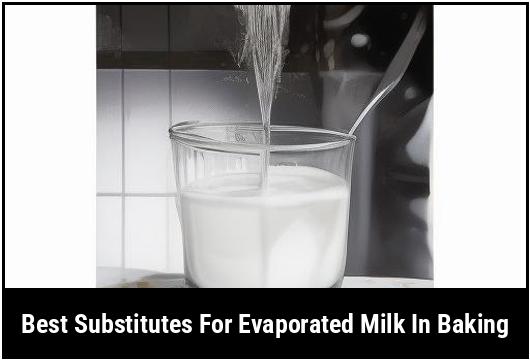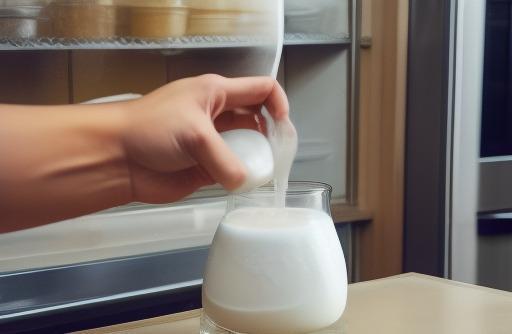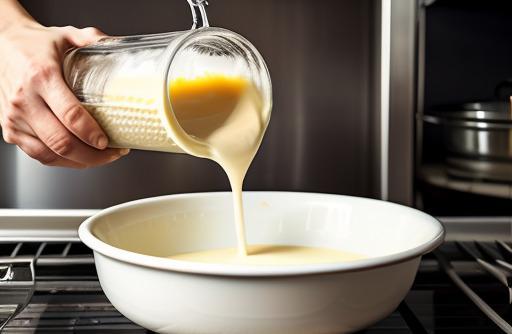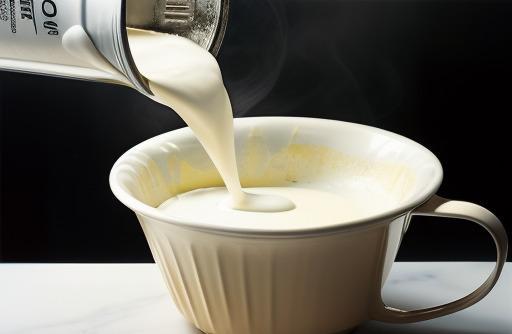Best Substitutes For Evaporated Milk In Baking

Evaporated milk is a common ingredient in many baked goods, providing richness, creaminess, and a touch of sweetness. However, there may be instances when you run out of evaporated milk or prefer to use a different ingredient due to dietary restrictions or personal preference.
In this article, we will explore various substitutes for evaporated milk in baking that you can use without compromising on taste and texture. We will also discuss how to choose the right substitute for your specific recipe and provide some delicious recipes to try with these substitutes.
Key Takeaways
- Evaporated milk is a commonly used ingredient in baking for its creamy texture and added sweetness.
- There are several substitutes for evaporated milk in baking, including regular milk, homemade evaporated milk, cream, half-and-half, coconut milk, and almond milk.
- The choice of substitute depends on the desired taste, texture, and dietary restrictions of the recipe.
- When using substitutes for evaporated milk in baking, it is important to adjust the measurements accordingly to maintain the right consistency.
- Substitutes for evaporated milk can be stored in the refrigerator for a few days or frozen for longer-term use.
Why You Need A Substitute For Evaporated Milk In Baking
There are several reasons why you might need a substitute for evaporated milk in your baking endeavors. Here are a few common scenarios:
-
Allergy or Intolerance: If you or someone you are baking for has a dairy allergy or lactose intolerance, regular evaporated milk may not be suitable. Using a substitute that is non-dairy or lactose-free can allow everyone to enjoy your baked goods.
-
Vegan or Plant-Based Diet: If you follow a vegan or plant-based diet, you may prefer to use plant-based substitutes for evaporated milk in your baking. This allows you to achieve the desired texture and flavor while adhering to your dietary choices.
-
Unavailable or Running Out: Sometimes you may simply not have evaporated milk on hand or run out unexpectedly. In such cases, knowing alternative ingredients that can provide similar properties can save your baking project.
-
Preference for Different Flavors: Evaporated milk has a distinct creamy and slightly sweet taste. If you prefer a different flavor profile in your baked goods, using a substitute can help you achieve the desired taste.
Types Of Substitutes For Evaporated Milk In Baking

When considering substitutes for evaporated milk in baking, there are various options, each with its own unique taste and texture. Here are some common substitutes and their properties:
-
Regular Milk: Regular milk, whether whole milk or low-fat, can be used as a substitute for evaporated milk. It provides a similar creamy texture and slightly sweet taste. However, it is important to note that regular milk has a higher water content, so adjustments will need to be made to maintain the desired consistency in recipes.
-
Homemade Evaporated Milk: If you have the time and inclination, you can make your own evaporated milk at home using regular milk. This allows you to control the sweetness and consistency according to your preference. Homemade evaporated milk generally has a richer taste compared to store-bought versions.
-
Cream: Cream is a great substitute for evaporated milk in baking when you want an extra indulgent and creamy texture. It has a higher fat content compared to evaporated milk, providing a luxurious mouthfeel. However, it is important to note that using cream may result in a heavier final product.
-
Half-and-Half: Half-and-half is a combination of equal parts whole milk and cream, making it a suitable substitute for evaporated milk. It provides a balance between the creaminess of cream and the lower fat content of regular milk. Like cream, using half-and-half can result in a richer texture in your baked goods.
-
Coconut Milk: For those looking for a dairy-free and vegan option, coconut milk can be an excellent substitute for evaporated milk in baking. It adds a subtle coconut flavor and richness to your recipes. It is important to use canned coconut milk, not the refrigerated carton variety, as the latter is too thin to mimic evaporated milk.
-
Almond Milk: Almond milk is another dairy-free and vegan substitute for evaporated milk. It has a mild nutty flavor and a thinner consistency compared to evaporated milk. When using almond milk as a substitute, it is essential to choose the unsweetened variety to avoid adding unwanted sweetness to your baked goods.
Best Substitutes For Evaporated Milk In Baking

-
Regular Milk: Regular milk is the closest substitute for evaporated milk. To use regular milk as a substitute, combine equal parts milk and heavy cream in a saucepan. Simmer the mixture over medium-low heat until it reduces by about half, creating a thicker and creamier consistency similar to evaporated milk. This homemade version of evaporated milk is an ideal substitute when you want a similar taste and texture. Adjust the amount of regular milk used in the recipe to account for the added water content.
-
Homemade Evaporated Milk: Making your own evaporated milk at home allows you to customize the sweetness and consistency according to your preference. To make homemade evaporated milk, bring 2 cups of regular milk to a simmer over medium-low heat. Let it simmer gently, stirring occasionally, until it reduces by half and thickens. This process usually takes about 1 to 1.5 hours. The resulting evaporated milk will be richer and creamier compared to store-bought versions. Adjust the amount of homemade evaporated milk used in your recipe based on the desired consistency.
-
Cream: Cream adds extra richness and creaminess to your baked goods, making it an excellent substitute for evaporated milk when you want a more indulgent result. To use cream as a substitute, use an equal amount of cream as the recipe calls for evaporated milk. Keep in mind that the final product may be denser and heavier due to the higher fat content of cream.
-
Half-and-Half: Half-and-half serves as a balanced substitute for evaporated milk, combining the creaminess of cream with the lower fat content of regular milk. To use half-and-half, replace the evaporated milk with the same amount of half-and-half in your recipe. Keep in mind that the final product may be slightly lighter in texture compared to using cream.
-
Coconut Milk: To replace evaporated milk with coconut milk, use the same amount of canned coconut milk. Shake the can well before opening to ensure the coconut cream is well mixed with the liquid. Coconut milk adds a subtle tropical flavor to your baked goods and works particularly well in recipes that pair well with coconut, such as tropical cakes or coconut macaroons.
-
Almond Milk: Use unsweetened almond milk as a non-dairy, vegan substitute for evaporated milk. Keep in mind that almond milk has a thinner consistency compared to evaporated milk. To compensate, you can add 1-2 tablespoons of cornstarch to every cup of almond milk used in the recipe to thicken it slightly.
Choosing The Right Substitute For Evaporated Milk In Baking

When choosing a substitute for evaporated milk in baking, consider the following factors:
-
Taste: Different substitutes will provide slight variations in taste. Regular milk, cream, and half-and-half will provide a similar taste to evaporated milk, while coconut milk and almond milk will add their unique flavors to the baked goods. Consider the desired flavor profile of your recipe and choose a substitute accordingly.
-
Texture: The texture of the substitute is crucial for the success of your baked goods. Regular milk and homemade evaporated milk will provide a similar creaminess to the final product. Cream and half-and-half will add richness and denseness, while coconut milk and almond milk may result in a lighter texture. Consider the desired texture of your baked goods when selecting a substitute.
-
Dietary Restrictions: If you or someone you are baking for has dietary restrictions, such as dairy allergies or a vegan diet, opt for non-dairy substitutes like coconut milk or almond milk. Make sure to choose unsweetened versions to avoid altering the sweetness of your baked goods unintendedly.
-
Recipe Compatibility: Some recipes may require the specific properties of evaporated milk, such as its ability to withstand high temperatures without curdling or separating. In such cases, it is best to stick to the original recipe or find a suitable substitute that can mimic those properties. For most baking recipes that call for evaporated milk, however, the substitutes mentioned above will work well.
In most cases, the proper substitute will depend on personal preference and the specific requirements of the recipe. You may need to experiment with different substitutes to find the one that best suits your needs.
Cooking With Substitutes For Evaporated Milk In Baking

When cooking with substitutes for evaporated milk in baking, it is important to make a few adjustments to ensure the desired consistency and taste of the final product. Here are some tips to keep in mind:
-
Adjust the Amount: As mentioned earlier, substitutes for evaporated milk have different consistencies compared to the original ingredient. To maintain the desired texture, adjust the amount of substitute used in the recipe accordingly. If using regular milk, consider reducing the other liquids in the recipe to compensate for the higher water content.
-
Monitor the Baking Time: Substitutes for evaporated milk may affect the baking time of your recipe. Keep an eye on the baking time and check for doneness using a toothpick or cake tester. Adjust the baking time as needed, as the substitute may require more or less time to reach the desired consistency.
-
Consider the Flavor: Substitutes like coconut milk and almond milk will add their own flavor to the baked goods. Consider how the added flavor will complement or enhance the other ingredients in the recipe. For example, coconut milk works well with tropical flavors, while almond milk pairs nicely with almond or vanilla flavors.
-
Cornstarch Thickening: If using substitutes like almond milk that have a thinner consistency, you can add 1-2 tablespoons of cornstarch per cup of substitute used. This will help thicken the mixture and provide a texture more similar to evaporated milk. Dissolve the cornstarch in a small amount of cold water before adding it to the recipe to prevent clumping.
Recipes Using Substitutes For Evaporated Milk In Baking

Now that you are familiar with the best substitutes for evaporated milk in baking, here are a few delicious recipes you can try out using these substitutes:
1. Classic Pumpkin Pie
Ingredients:
- 1 ½ cups pumpkin puree
- 1 cup substitute for evaporated milk (e.g., homemade evaporated milk, coconut milk)
- ¾ cup granulated sugar
- ½ teaspoon salt
- 1 teaspoon ground cinnamon
- ½ teaspoon ground ginger
- ¼ teaspoon ground cloves
- 2 large eggs
- 1 unbaked pie crust
Instructions:
- Preheat the oven to 425°F (220°C).
- In a large bowl, whisk together the pumpkin puree, substitute for evaporated milk, sugar, salt, cinnamon, ginger, and cloves until well combined.
- Beat the eggs in a separate bowl, then add them to the pumpkin mixture. Mix until fully incorporated.
- Pour the pumpkin filling into the unbaked pie crust.
- Bake the pie for 15 minutes, then reduce the oven temperature to 350°F (175°C). Continue baking for an additional 40-50 minutes or until the center is set.
- Remove the pie from the oven and let it cool completely before serving.
2. Creamy Alfredo Pasta
Ingredients:
- 8 ounces fettuccine pasta
- ¼ cup unsalted butter
- 1 cup substitute for evaporated milk (e.g., regular milk, half-and-half)
- 1 cup grated Parmesan cheese
- Salt and pepper to taste
- Chopped fresh parsley for garnish
Instructions:
- Cook the fettuccine pasta according to the package instructions until al dente. Drain and set aside.
- Melt the butter in a large skillet over medium heat.
- Add the substitute for evaporated milk to the skillet and simmer for a few minutes, stirring occasionally.
- Gradually whisk in the grated Parmesan cheese until fully melted and incorporated.
- Season with salt and pepper to taste.
- Add the drained fettuccine to the skillet and toss to coat the pasta evenly with the Alfredo sauce.
- Garnish with chopped fresh parsley and serve immediately.
These recipes demonstrate how versatile and delicious substitutes for evaporated milk can be in baking and cooking. Feel free to experiment and adjust the recipes based on your preferences and dietary needs.
Storage And Shelf Life Of Substitutes
When using substitutes for evaporated milk in baking, it is important to consider their storage and shelf life:
- Regular Milk: Store regular milk in the refrigerator and use it before the expiration date.
- Homemade Evaporated Milk: Homemade evaporated milk can be stored in an airtight container in the refrigerator for up to 3-4 days.
- Cream: Keep cream refrigerated and use it before the expiration date. Opened cream will last around 7-10 days in the fridge.
- Half-and-Half: Similar to cream, store half-and-half in the refrigerator and use it before the expiration date. Opened half-and-half will last around 7-10 days in the fridge.
- Coconut Milk: Canned coconut milk can be stored at room temperature until opened. Once opened, transfer any leftover coconut milk to an airtight container and refrigerate. Use within 3-4 days.
- Almond Milk: Refrigerate almond milk after opening and use it within 7-10 days or according to the manufacturer’s instructions.
If you have leftover substitutes for evaporated milk, consider freezing them in an airtight container for longer-term storage. Thaw them in the refrigerator before using and shake or whisk them well to recombine any separated liquid.
Conclusion
Using substitutes for evaporated milk in baking can open up a world of possibilities for those with dietary restrictions or personal preferences. Whether you opt for regular milk, homemade evaporated milk, cream, half-and-half, coconut milk, or almond milk, each substitute brings its unique taste and texture to your baked goods.
When choosing a substitute, consider the taste, texture, dietary restrictions, and recipe compatibility. Make necessary adjustments in measurements and baking time to achieve the desired results. With a bit of experimentation, you can discover the perfect substitute for evaporated milk that suits your baking needs.
So, the next time you find yourself without evaporated milk or simply want to try something different, don’t hesitate to explore these substitutes and enjoy the delicious results. Happy baking and cooking!
Pro Tip: When using substitutes for evaporated milk in baking, make sure to adjust the sweetness of the recipe accordingly. Some substitutes, such as coconut milk or homemade evaporated milk, may have different levels of sweetness compared to store-bought evaporated milk. Taste the batter or mixture before baking and add additional sugar if needed.
FAQS
What Is Evaporated Milk?
Evaporated milk is milk that has been cooked at a low temperature to remove about 60% of the water content, resulting in a thicker, creamier and more concentrated milk product.
What Are The Reasons For Substituting Evaporated Milk In Baking?
There may be several reasons to substitute evaporated milk in baking, such as lactose intolerance, vegan or plant-based dietary restrictions, or unavailability of evaporated milk.
What Are The Best Substitutes For Evaporated Milk In Baking?
Some of the best substitutes for evaporated milk in baking are: equal parts heavy cream or half-and-half, coconut cream, soy milk, almond milk, or cashew milk.
How Can I Substitute Evaporated Milk With Heavy Cream Or Half-and-half In Baking?
You can substitute 1 cup of evaporated milk with 1 cup of heavy cream or half-and-half if you are looking for a thicker and creamier texture. However, it may add more calories and fat content to your recipe.
Can I Use Water Instead Of Evaporated Milk In Baking?
It is not recommended to use water instead of evaporated milk in baking as it may dilute the flavor and texture of your recipe. It is better to use one of the suggested substitutes for evaporated milk to maintain the integrity of your baked goods.
Sources
About the Author Jenny
I'm Jenny, a housewife with an unwavering passion for food. My culinary journey began with my grandmother's kitchen, and it's now a full-fledged food blog. I've turned my love for cooking into a creative outlet, sharing recipes and stories with a global community of fellow food enthusiasts. It's proof that being a housewife can also mean pursuing your passions and savoring life's delectable moments.
